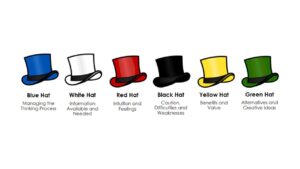Turn meetings from terrible to tremendous with Six Thinking Hats by Caryn Douglas
In 2017, in an article entitled “Stop the Meeting Madness”, Harvard Business Review reported that executives spend an average of 23 hours in meetings. Even then, this was an increase of 13% from the time spent in the 1960s. Nearly everyone who has worked in a meeting-heavy environment can report on meetings that have taken twice as long as they needed to, or were totally unnecessary.
Some simple measures can be put in place to help this overload – clearly written agendas can help people know if a meeting is worth their time. Observation of prompt start and set end times can also help. Good chairing and notetaking is essential. Organisational culture plays a big role in whether these simple measures happen or not. But even when they are in place, once people are in the room agendas are abandoned, debates and disagreements take up more than their fair share of time, no time is available for creative thinking, and no agreements or decisions are made.
 Edward de Bono’s Six Thinking Hats are a tried and tested way of keeping discussions on track, reducing overall meeting times, improving the quality and tenor of debate, resulting in decisions that everyone in a meeting can feel they played a part in reaching. Google “six thinking hats” and you will find lots of descriptions of the hats and what they are used for. Incidentally, de Bono chose hats quite deliberately: we already “put on our thinking caps”, and “wear different hats” in different situations, so the concept already exists in popular language. It is also worth noting that the Hats are not a personality measure – the idea is that everyone uses all the Hats, even if they have a preference to contribute under one over others.
Edward de Bono’s Six Thinking Hats are a tried and tested way of keeping discussions on track, reducing overall meeting times, improving the quality and tenor of debate, resulting in decisions that everyone in a meeting can feel they played a part in reaching. Google “six thinking hats” and you will find lots of descriptions of the hats and what they are used for. Incidentally, de Bono chose hats quite deliberately: we already “put on our thinking caps”, and “wear different hats” in different situations, so the concept already exists in popular language. It is also worth noting that the Hats are not a personality measure – the idea is that everyone uses all the Hats, even if they have a preference to contribute under one over others.
So how does it work in practice?
It works by using the concept of parallel thinking, ie. everyone wearing the same hat at the same time. This works brilliantly to take ego out of a situation, as it aligns people to look through the same lens, rather than pushing their own agendas simultaneously.
The “blue hat” plays a critical role. They keep all participants in line during a meeting, make sure the meeting has an agenda and the focus of any decisions that need making is clear. They are essential to:
- ensure that everyone is wearing the “right hat” at the right time
- signal when it is time to take one hat off and put on a different one, to a pre-agreed timescale
- shut down contributions that are not related the current hat
The principle is hard to argue against, because everyone gets their moment. The doom and gloom-sayers have their time under the black hat. The rosy-spectacles brigade get their say under the yellow hat. And anyone who is really annoyed about the whole thing, gets to say so under the red hat –often being given “permission” to say we’re annoyed about something goes a long way to diffusing that annoyance and allows us to focus on moving forward. And time is protected for the critical tasks of assembling indisputable facts, and creativity.
There are many more nuances to using the Hats, but if you find yourself wasting time in meetings with no focus or endless debate, you would do well to consider using Hats to align group thinking, take ego out of the mix, to get better quality decision-making and commitment to those decisions!
Reference
Leslie A, Perlow, LA, Noonan Hadley, C, and Eun, E, Stop the meeting madness, Harvard Business Review, Jul–Aug 2017 pp.62–69. https://hbr.org/2017/07/stop-the-meeting-madness